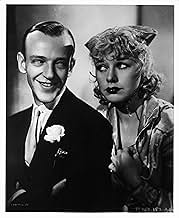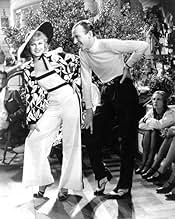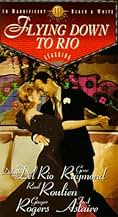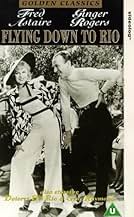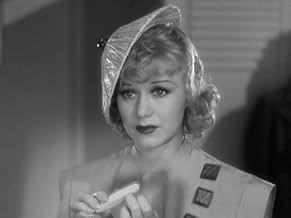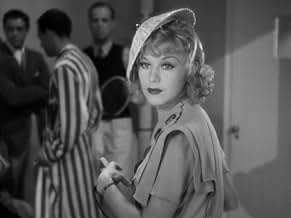Roger, un músico americano, se enamora de Belinha De Rezende, una aristócrata brasileña. Pero ella ha de regresar a Brasil a casarse para salvar a su padre. Roger, acompañado por su banda, v... Leer todoRoger, un músico americano, se enamora de Belinha De Rezende, una aristócrata brasileña. Pero ella ha de regresar a Brasil a casarse para salvar a su padre. Roger, acompañado por su banda, viajará hasta Brasil para impedir el matrimonio.Roger, un músico americano, se enamora de Belinha De Rezende, una aristócrata brasileña. Pero ella ha de regresar a Brasil a casarse para salvar a su padre. Roger, acompañado por su banda, viajará hasta Brasil para impedir el matrimonio.
- Dirección
- Guionistas
- Elenco
- Nominado a 1 premio Óscar
- 1 premio ganado y 2 nominaciones en total
- Belinha De Rezende
- (as Dolores Del Rio)
- Rio Casino Manager
- (sin créditos)
- Singer
- (sin créditos)
- Check Girl
- (sin créditos)
Opiniones destacadas
When Roger meets Belinha in the hall of the hotel, he learns that she lost her flight to Rio and he offers a ride for her in his plane. Roger is forced to land in an island and he immediately fixes the mechanical problem in the plane; however, he lies to Belinha and tells that he can not fix the problem just to spend the night alone with her. But Belinha, who is the fiancée of the Brazilian Júlio, resists to his harassment and later she finds another plane to fly to Rio.
Once in Rio, the infatuated Roger meets his friend Júlio without knowing that he is the fiancé of Belinha, and he tells about his love for the woman. When the Yankee Clippers are ready to open the hotel, powerful bankers that are interested to force the bankruptcy of the Atlântico's owner to take the hotel, send the police since he does not have the permit to anticipate the opening day. However, Roger's friend and musician Fred Ayres (Fred Astaire) proposes an airborne show to the guests. Meanwhile, the brokenhearted Roger decides to return to his country and leave Belinha with Júlio.
"Flying Down to Rio" is the debut of the pair Fred and Ginger in minor support roles. The sappy and naive romance has the Mexican Dolores Del Rio performing a Brazilian sassy woman and Gene Raymond in the lead roles. The footages from Rio de Janeiro in the 30's and the airborne show are the best moments of this film. The funniest thing in "Flying Down to Rio" is that there is no Brazilian actor or actress in the cast. My vote is six.
Title (Brazil): "Voando para o Rio" ("Flying to Rio")
This is a 1933 movie short on plot and, as is often the case with the early talkies, a little slow in parts due to the pace of the dialogue. It is nevertheless a fun movie, with Astaire doing some wonderful solo dancing and of course, his dance with Ginger, which sent them on their way to movie history.
The stars of the film are Dolores Del Rio and Gene Raymond. After bandleader Raymond meets del Rio in the U. S., he ends up in Rio where he competes for her attentions with her fiancé Julio (Raul Roulien), his best friend.
The plot concerns the opening of a hotel in Rio and its planned takeover by another group. When the opening date is changed, the owner cannot get another performing license, so all seems to be lost.
Thus the number "Flying Down to Rio" with chorus girls doing maneuvers on the wings of flying planes. It's a spectacular part of the film, though in spots you can really see how fake it was. It doesn't really matter - it was early film-making where, without the use of computers, artistry and imagination were needed instead, and much was accomplished.
There are some interesting editing experiments noticeable as well, particularly during a big nightclub scene. It was precode, so some of the numbers are pretty darn steamy.
Dolores del Rio was surely one of the most stunningly beautiful women ever to appear on screen. Growing up, I remember seeing Sunday supplements with articles and photos about her current life - it was a good 30 years after this film - and her beauty remained awesome without the plastic surgery techniques available today. She was a true, fantastic beauty, and this film really showcases it.
This isn't the most wonderful musical you'll ever see but it's important nonetheless: It launched Rogers & Astairs, it's an interesting example of early editing, and it's precode. And if you watch it with the wonder that the depression audiences must have had, you'll enjoy it even more.
So Hollywood turned out films like this one, escapist fare about rich dilettantes drifting back and forth from Miami to Rio. Indeed, the hero of this little trifle, Gene Raymond, is the scion of a wealthy family who will inherit lots of money, if he gives up fiddling around with song writing and aviation. And the thing is, pictures liked this one worked. The unemployed probably didn't have the ten cents or more it took to get in to see gems like this, but those who did have the money turned out for this kind of picture, gawking at the upper classes in wonder.
"Flying down to Rio," though, is an early talkie and hardly the best example of this kind of romantic comedy. Directed by Thornton Freeland, an early talkie director whose career was largely undistinguished, it has a loose feel about it and does not marry sound and visuals together with any real skill. The pacing is bad, the musical numbers drag on way too long and the film is not the kind of polished production RKO and the rest of Hollywood would start turning out within the next few years.
But "Flying Down to Rio" is remembered today for one thing and one thing only, the first pairing of Fred Astaire and Ginger Rogers, who would become the greatest dance team in movie history. That pairing almost didn't happen, because Ginger's role was originally earmarked for starlet Dorothy Jordan, who wound up catching the eye of Merian C. Cooper, then riding high at RKO after the spectacular success of "King Kong." Jordan became Cooper's girlfriend and quickly his wife and Ginger stepped into her dance shoes and from there into screen immortality. Ironically, Fred and Ginger are not the leads in this film and actually only do one dance number together, but they were good enough to convince the powers that be that new stars had been born, providing those stars could dance their way through their future films.
But aside from that number, there are a couple of other reasons to see this film. The first is top billed star Dolores Del Rio, one of the most beautiful women to ever turn up on the screen. A wealthy socialite from Mexico, she arrived in Hollywood in the silent era and became famous playing a French peasant girl being romanced by two American soldiers in "What Price Glory." Her transition to sound was rocky, though, not because of her voice, but rather what felled many a silent star, her "foreign accent." But it didn't kill her. She returned to Mexico and helped launch its film industry.
Aside from Del Rio, the other things to look for are the Depression era sets. Built to depict hotels and elaborate supper clubs, they are among the most spectacular of the era. And then, finally, there is that other sequence this film is known for, the truly amazing production number featuring the title song, "Flying Down to Rio" in which a bevy of beautiful girls allow themselves to be strapped to the wings of biplanes and flown over Rio as entertainment during the opening of a hotel. While the overwhelming majority of the footage are probably process shots, there appear to be a couple of real life wing walker type shots blended in to give the sequence a realistic feel.
Merian Cooper, then RKO's defacto production boss, was among many other things a pilot himself, an aviation buff and one of the founders of Pan American Airways, the airline that pioneered trans-ocean flight. And even before the famed Pan Am Clippers crossed the Atlantic and the Pacific in the mid-thirties, they'd already established mail and early passenger service to South America with the Sikorsky S-40 nd S-42 flying boats,shown at the end of the film.
In some ways, this film is one big advertisement for the Clippers and for aviation, back when it looked like fun. But then, the real fun was watching Astaire and Rogers in subsequent films proving that in addition to having a good eye for manly stuff like big gorillas and airplanes, Merian C.Cooper was not exactly blind to musical talent, either.
`Flying Down to Rio' is a classic pre-Hayes code talkie, and its characters have a quality of frankness which endears them to modern audience far more than many later films, whose stilted, conservative quality is somewhat alienating. You'd be surprised at what they could get away with in those days - it would be forty years before a film could get away with a line like that spoken by a starlet of her South American rivals - `What have those girls got below the equator that we haven't got?'
The film, about a love triangle between a Brazilian woman and two members of a swing band, is of course famous for two things - the slightly surreal sequence in which showgirls ride a biplane down to Rio in Busby Berkley-esque formation, and the debut of Fred Astaire and Ginger Rogers as a screen team. It's no wonder that audiences fell in love with the duo, whose `Carioca' is the highlight of the film.
They only made them like this for a little while - more's the shame!
¿Sabías que…?
- TriviaStanding outside a bakery shop in Rio, Ginger Rogers asks, "Oh, Freddie, how do you ask for little tarts in Portuguese?" Fred Astaire replies, "Don't heckle me, try the Culbertson System." This pre-Code, double entendre joke would have been funny to Depression-era audiences, for whom bridge was a common pastime. Ely Culbertson was a champion bridge player and worldwide celebrity, who had won several international tournaments by developing a rather aggressive bidding system. He was also notorious for his sexual exploits. His 1940 autobiography was banned in many countries. In the 1930s, the word "tart" was equivalent to "slut" or "whore". Also, in the opening inspection of hotel staff, the boss sees a maid whose shoe heels are oddly beveled and says he will not tolerate that sort of thing. A "round-heeled woman" was 1930s slang for a prostitute, a woman who could tilt easily from standing to being on her back.
- ErroresFrom the height they were flying, most of the "dance" routines of the young women on the plane wings would not be visible to people on the ground.
While true, this observation is not a Goof. The purpose of the event likely was more for advertising or Newsreel value, or even simply "bragging rights".
- Citas
Belinha's Friend: What have these South Americans got below the equator that we haven't?
- ConexionesFeatured in Hollywood and the Stars: The Fabulous Musicals (1963)
- Bandas sonorasMusic Makes Me
(1933) (uncredited)
Music by Vincent Youmans
Lyrics by Gus Kahn and Edward Eliscu
Performed by Ginger Rogers
Selecciones populares
- How long is Flying Down to Rio?Con tecnología de Alexa
Detalles
Taquilla
- Presupuesto
- USD 462,000 (estimado)
- Tiempo de ejecución1 hora 29 minutos
- Color
- Relación de aspecto
- 1.37 : 1
Contribuir a esta página



